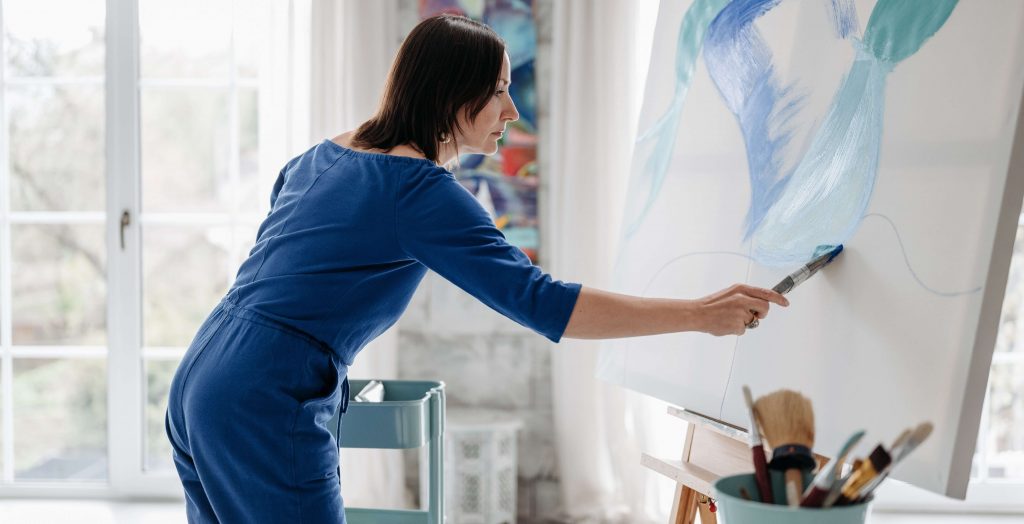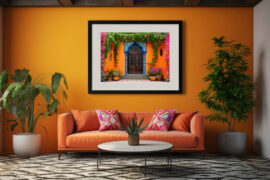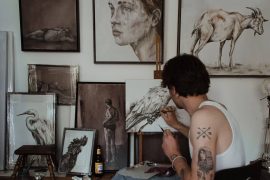India is known for its cultural diversity, and one can experience it in the folk arts and crafts of the country. India is known for its exceptional painting styles across different regions, which is a testimony of its customs and traditions. The majority of the Indian painting styles exist as wall paintings, cloth paintings, and even murals that exhibit the different art forms on canvas, paper, walls, etc. These paintings represent emotions, thoughts, and feelings based on the neural flora, fauna, respect for deities, and mythology which can be found on IndiGalleria. Let us look at some of the renowned types of painting in India.
10 Types of Painting in India
1. Madhubani Paintings
The folk art of Bihar, originally the Madhubani Paintings from Bihar, is a traditional Indian Art form distinguished for using the local plants for colors, treating the surface of the paper with cow dung, and using wood, typically bamboo sticks for brushes. It is also known as Mithila Painting.
The Madhubani paintings feature geometrical shapes and patterns, one of India’s most famous folk-art forms. Many artists who create Madhubani art have received much recognition for their talent and awards, namely Padma Shri and other National awards.
2. Warli Paintings
Warli paintings are an art form from Maharashtra, India. They are one of the finest art forms in the folk style of paintings. The warli art generally depicts farming life and also portrays Mother Nature. It is a form of respect to make art for their natural habitat and wildlife around them.
This art form uses geometrical figures like squares, circles, and triangles. Its simplicity and elegance make it unique in depicting the various natural things that exist in nature, such as a circle trying to show the sun or the moon. In contrast, triangles show the conical trees and mountains. A square can be anything like a piece of land or a house. This art form is created inside the walls of village huts and painted with white color made of rice flour and water.
3. Kalighat Painting
The key highlight of Kalighat Painting is its bright colors and bold outlines, and this art is originally from Kolkata, West Bengal. They started by displaying the mythological characters first, but after some time, they started spreading their variety to other themes.
These paintings had mythological depictions of Hindu Gods and Goddesses and included in their themes daily life and societal references. The painting looks simple but is meticulous work. It starts with an outline of pencil work where the thick and thin boundaries depict different areas of the body. These paintings are themes based on religious and non-religious topics. You often see paintings featuring women and their way of adorning their bodies. Today painting practice is different from the past. But it remains one of India’s most distinct, meticulous, and beautiful forms of artwork.
4. Phad
Phad is a folk painting originally from the state of Rajasthan. This painting is on canvas or long pieces of cloth. These paintings, too, depict the heroic life of the Gods painted on the pieces of clothes and put up a whole story about it. The characters made in these paintings are telling a story or putting out a drama in front of the onlookers, so they never face the audience but instead each other. The pictorial surface of the clothing is flat, and the characters are distributed all over the space with their scale of size, telling their role in the story.
5. Kalamkari
We can paint Kalamkari paintings on a cotton textile, using only natural dyes made from vegetables to paint on them. As a folk art, we use it to represent culture and religion. The best part is that it connects our history and mythology intertwined with our humanity and history.
It originated from Andhra Pradesh, and Telangana states hundreds of years ago. There are two types of Kalamkari paintings, namely, Srikalahasti and Machilipatnam.
This art form was also taken over in the family businesses and passed down from generation to generation. In Andhra Pradesh, people have practiced this art form to earn money.
6. Miniature Painting
Miniature Paintings are very small, vibrant, and colorful paintings. They are unique in how their details are marked and painted, and the brushwork is intricate and detailed.
Since it’s a folk art too, people used traditional ways of making the colors from vegetables, precious stones, Gold, silver, and indigo.
What started as a need for people to aid them in understanding manuscripts and documents by illustrating facts later became a famous folk art, the miniature painting. That’s why it connects with book art. It is not just restricted to paintings but also engravings and sculptures.
7. Gond Painting
Gond paintings are folk art practiced by the Gond tribe in India. Unlike other folk arts, the Gond art preserves and connect the Gond culture and community with different parts and cultures of India. The Gond tribe is the biggest in India, and they reside in the states of Madhya Pradesh, Maharashtra, Telangana, Odisha, Andhra Pradesh, and Bihar.
The word ‘Kond,’ which means green mountains and tribal people, is the word from which the word Gond comes, as they live mostly in lush green areas and forests.
According to their belief looking at good things brings more good luck. Therefore, on every auspicious occasion, it is a tradition to paint Gond art and represent it as a form of respect and lucky charm.
8. Kerala Murals
Kerala Murals are a method of painting done on the walls or ceilings, where the colors penetrate and get fixed in the plaster. To date, the mural paintings of Kerala are the most iconic symbol of the religion’s culture and artistic traditions.
The history of Kerala Murals started as being influenced by Kerala’s Topography and Nature. Later, the cultural province and the bhakti activities too enthused the painters.
The Onam floral patterns and drawings on the ground are an offshoot of the Kerala murals style. The Kerala Murals are, on the surface, prepared by a painstaking process.
9. Patachitra
Patachitra or Pattachitra, which, when broken down into ‘patta’ means cloth and ‘Chitra’ means painting, is a general term for traditional based cloth-scroll painting. Patachitra is one of the ancient artworks famous for depicting Hindu divinity and figures. Something very common to the Indian Style of paintings is their vibrancy and intricate details, which Patachitra paintings have too.
They will have sharp and contrasting colors, elongated eyes, and detailed body parts. The paintings are the origins of Odisha and West Bengal. The paintings are in temples in Odisha and centers of Puri, Bhubaneshwar, and Konark. One of the most remarkable works can be found in the temples of Jagannath at Puri and Sun temple at Konark.
10. Pichhwai
Pichhwai Paintings are works of art that originated in the Nathdwara district of Udaipur, Rajasthan. These paintings are usually behind idols, which are made with many intricacies and are visually stunning. They are made of cloth, depicting tales of Krishna’s life. Creating a Pichhwai can take several months as it captures every detail.
These paintings are rich embroidery and applique work, with rich colors used within very dark borders. We also use Gold to adorn the painting, adding to its value and charm. Sadly, this type of artwork cannot get enough recognition and is losing its identity, and more recognition and revival can help in its survival.
Exceptional art collection forms and craftsmanship reflects the country’s rich cultural diversity. The different types of paintings from the other regions symbolize the country’s customs, traditions, and philosophies transmitted from one generation to the next. Each types of painting in India is unique in its Style and beauty. And if you invest some time you’ll realize all depict nature and mythological themes. These different types of painting in India get you to move back in time and cherish their true appreciation and rustic appeal.






